compiled by Brad Lancaster
Opuntia spp. –
Prickly pear
(Cactaceae – Cactus Family) subgroup Platyopuntia::
Spanish name: nopal
O’odham name: naw
Yeome name: naavo
Characteristics
Plants have flattened stems or “pads”. Evergreen.
Blue-green pads can be up to 12″ long. Can grow to 5′ tall.
Found on plains, hillsides, mesas, arroyos, and washes.
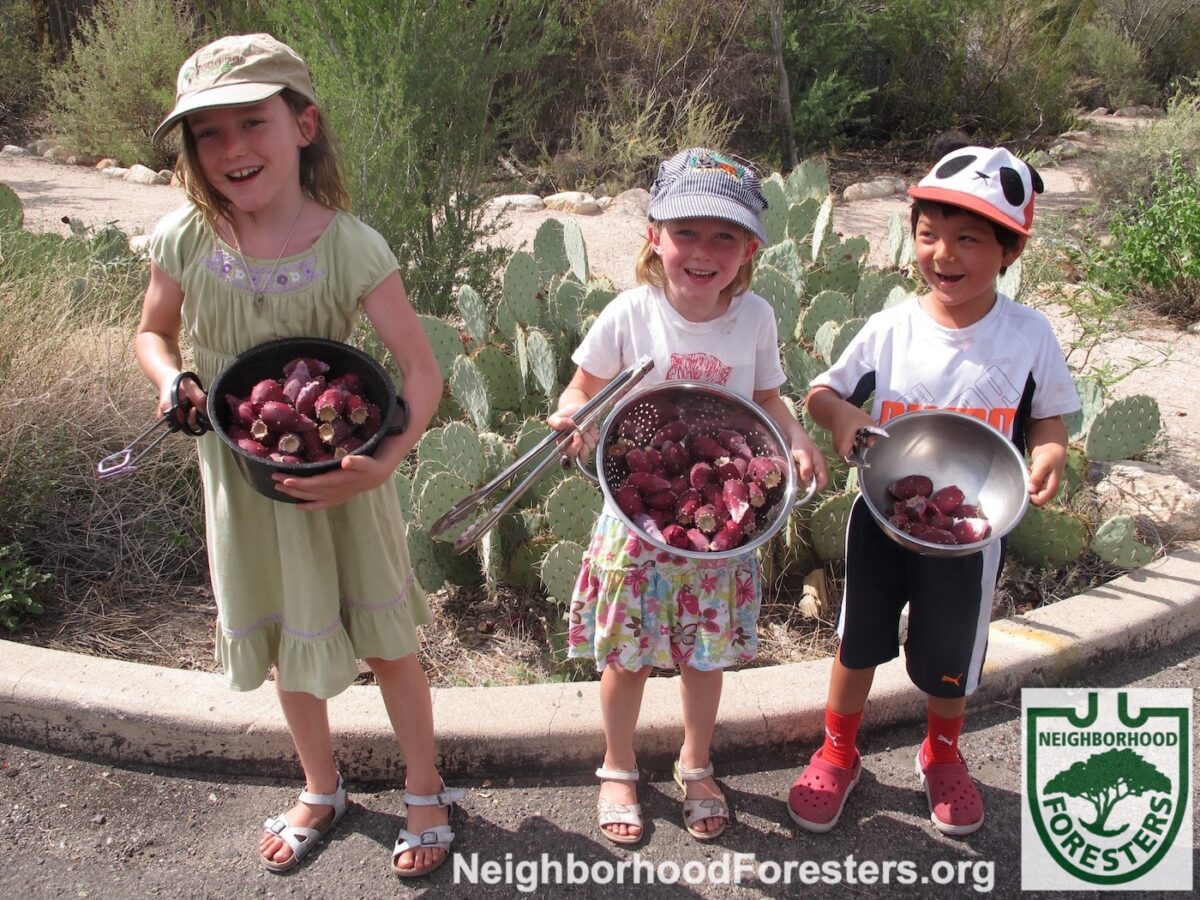
Photo: Brad Lancaster
Wildlife it supports
Bees love the flowers in spring. Non-stinging native solitary bees will sleep inside the flowers when they close up at night, then reemerge when all opens in the morning. White-winged dove, cactus wren, curve-billed thrasher, coyote, rabbits, ground squirrel, k-rat, javalina, and desert tortoise all go for the fruits and/or the seeds; cochineal scale insects (a source of red dye) feed on pads.

Photo: Brad Lancaster
Edible – ripe fruits eaten raw or cooked are a good source of vitamins A and C (Niethammer, 1987) and calcium (Niethammer, 1974); used in pasteries, juice, jams, syrup, beverages, and candied (Niethammer, 1987), (TOG); an easy way to process the fruits for syrup or juice is to freeze them (with thorns on them) after harvesting, then later thaw them out in a colindar lined with an old pillow case. As the fruits thaw they will collapse and you can easy mash and/or squeeze the juice through the pillow case and into a bucket below – that’s it! The thorns, seeds, and most of the pulp will remain in the pillow case. Empty the pulp and thorns out of the pillow case into your compost pile, and if you like save the seed to grind into flour. Seeds can be used in a wild flour mixture (Nyerges, 1998). Young pads are dethorned, cooked and eaten (Niethammer, 1987), (Bigfoot) – great for diabetics (Moore, 1989), (Dahl, 1995), (Nabhan, 1991), as with many wild foods, the prickly pear helps slow the body’s intake of sugars.
Do not harvest more than a third of the fruits on any plant, to leave enough for other harvesters, wildlife, and for so the plant can reproduce.
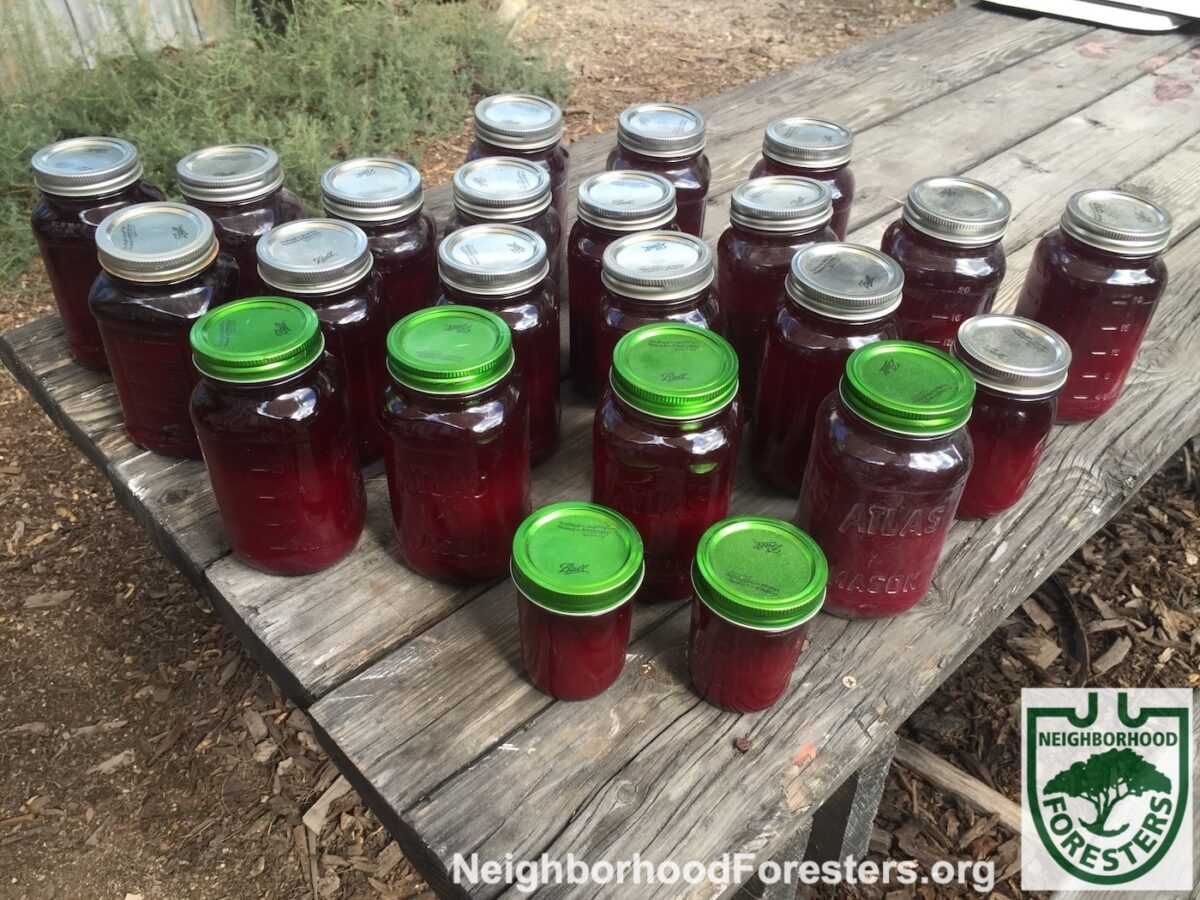
Thanks to John Slattery of DesertForager.com for the recipe.
Photo: Brad Lancaster
On a long desert hike I ate about half a dozen raw flower buds close to blooming and four young pads dethorned, and found them all filling and satisfying.
Fruit harvest July – September.
I’ve found the flower petals of many varieties to be edible and faintly sweet in flavor.
Caution – Peter Bigfoot has found eating pads from prickly pear with red-orange thorns made him ill, he has found prickly pears with all white thorns don’t seem to have this effect (Bigfoot). I also personally know people who get ill with “chills” if they ate too many fruits at one time, so don’t eat too much all at once.
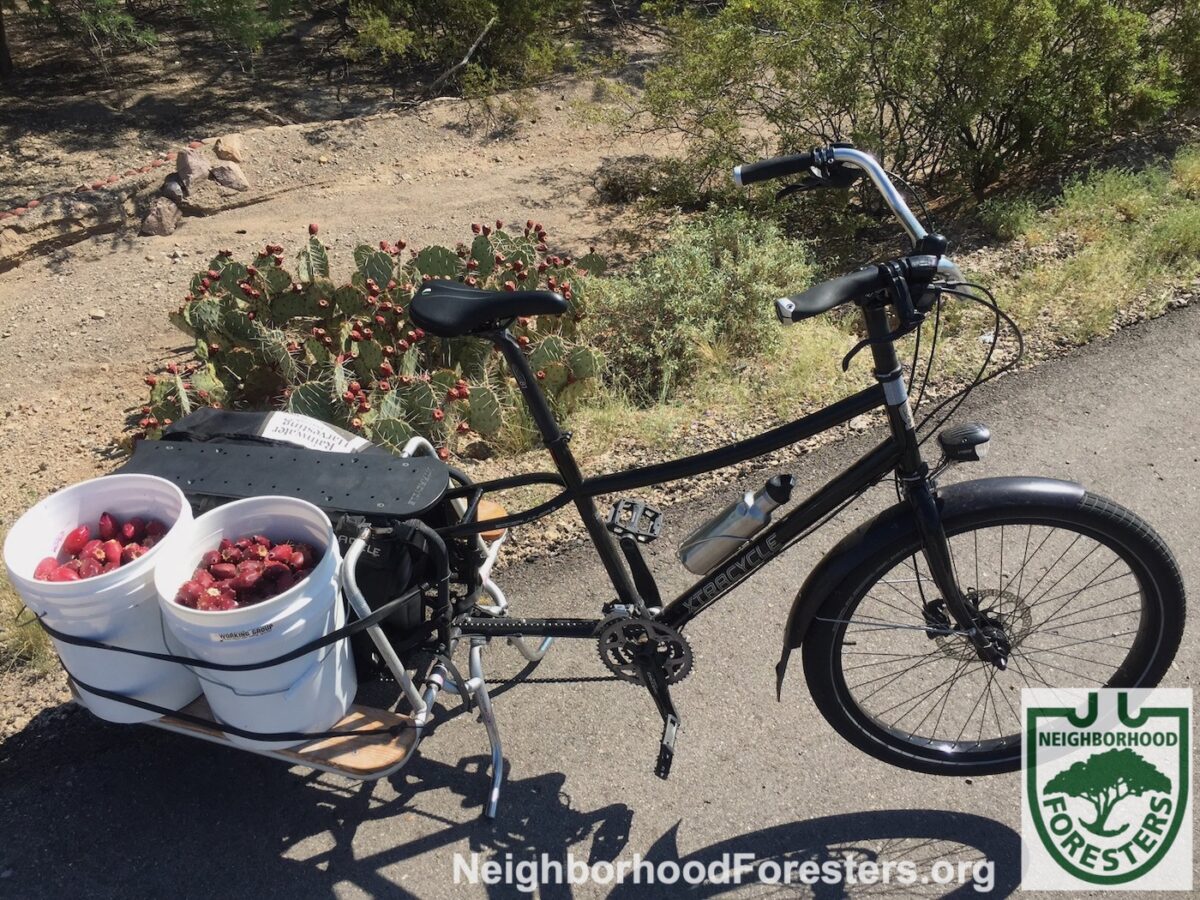
Photo: Brad Lancaster

Photo: Brad Lancaster
Livestock it supports
Cattle, goats, sheep, rabbits. More readily eaten if thorns are burnt off before eating.
Other uses – fruit used to make various colors of dye (Rieske), (Cheatham, 1998); white and fuzzy cochineal insect scales, Dactylopius coccus , feeding on the pads can be used for a high quality red dye (Las Aranas, 1995), (Ebeling, 1986); pads are a source of black pigment for painting ceramics (Swink, 1998); slimy juice from cut up cactus pads is sometimes added to whitewash (Cheatham, 1998); grilled pads dropped into muddy water reportedly clairfy the water (Cheatham, 1998), (Bigfoot); makes a great living fence; cattle will can eat the cactus if the thorns have been singed off (Niethammer, 1974). The prickly pear pads are also used to semi-stabalize (make more water resistant) adobe bricks and earth plasters (the thornless Opuntia ficus indica is the easiest to use, but thornier native species could be used). Cut the pads up, immerse them in water, and cover (as they ferment and decompose it will STINK), leaving 1 to 2 weeks. Once the water becomes slimy it is ready. Use this as your water source when you mix the adobe you wish to be semi-stabalized. This “cactus water” can also be diluted with 3 – 4 parts water when mixing lime plasters. If you’re working with old bags of lime the cactus juice can help restore the lime to fresher characteristics (easier to work and holds up better).
Medicinal (Bigfoot), (Curtin, 1997), (Kay, 1996), (Cheatham, 1998), (Niethammer, 1974).
Guild associates – foothills palo verde, cat claw acacia, desert ironwood, velvet mesquite, mormon tea, fairy duster, hopbush, sotol. LW (1).
Water needs
LW (1)
LW = low water 10 – 20 inches of water per year
“1” = no supplemental irrigation needed once established
Opuntia engelmannii
Englemann prickly pear
Blooms (yellow) April – June.
Fruits July – September. Fruit is red to reddish-purple when ripe. Found within 1,000 – 6,500′ elevation.
Blue-green pads can be up to 12″ long. Can grow to 5′ tall.
Found on plains, hillsides, mesas, arroyos, and washes.
Wildlife – solitary bees (Anthophoridae, Halictidae, Megachilidae) and sap bettles (Nitidulidae) visit the flowers (Turner, et al 1995); coyote, javalina, black bear, and desert tortoise go for the fruit and disperse the seed; javalina also eat pads with fewer thorns.
Edible – once the thorns are removed the sweet fruit can be eaten raw (Rea, 1997 ).
Other uses – thorns used for tattooing (Rea, 1997 ); fruit used for dye (Las Aranas, 1995).
Propagation
It’s easy!
Find a plant whose fruits you find delicious, then when the pads are plump and well hydrated (usually in the rainy season) cut off some pads. But first identify how the pad is oriented (for example, stick a leaf or some litter on a thorn on the side of the pad that faces west or south—the most intense sun sides). Then cut off the pad at the joint (where a pad connects to another pad) to minimize cut surface area.
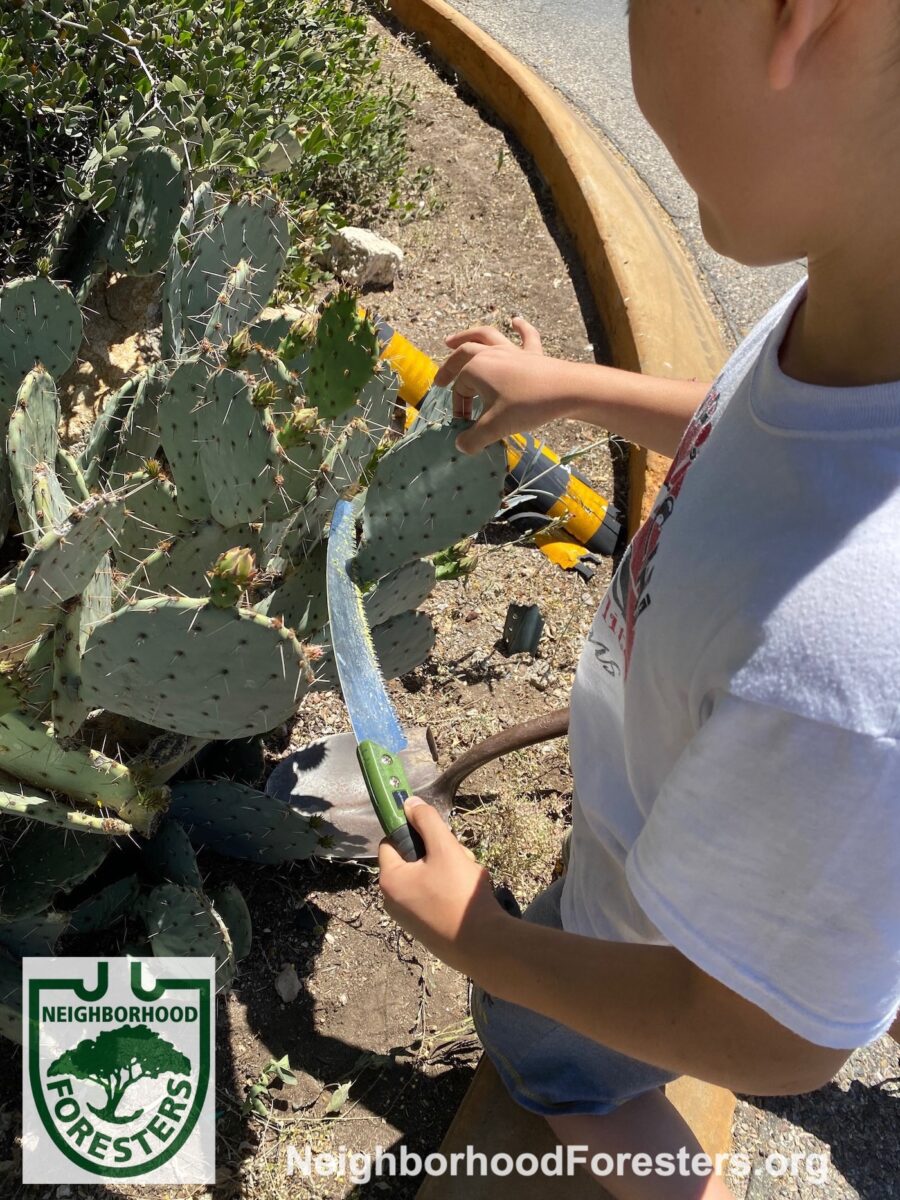
Photo: Brad Lancaster
Then plant in the ground within a shallow (six-inch deep) water-harvesting basin, orienting the pad so when in the ground it maintains the same orientation it had on the mother plant (this will reduce the chance of the newly planted pad getting sunburned. If a side of the pad that had always faced shade, like north, where suddenly oriented to the full sun to south or west it will more likely sunburn).
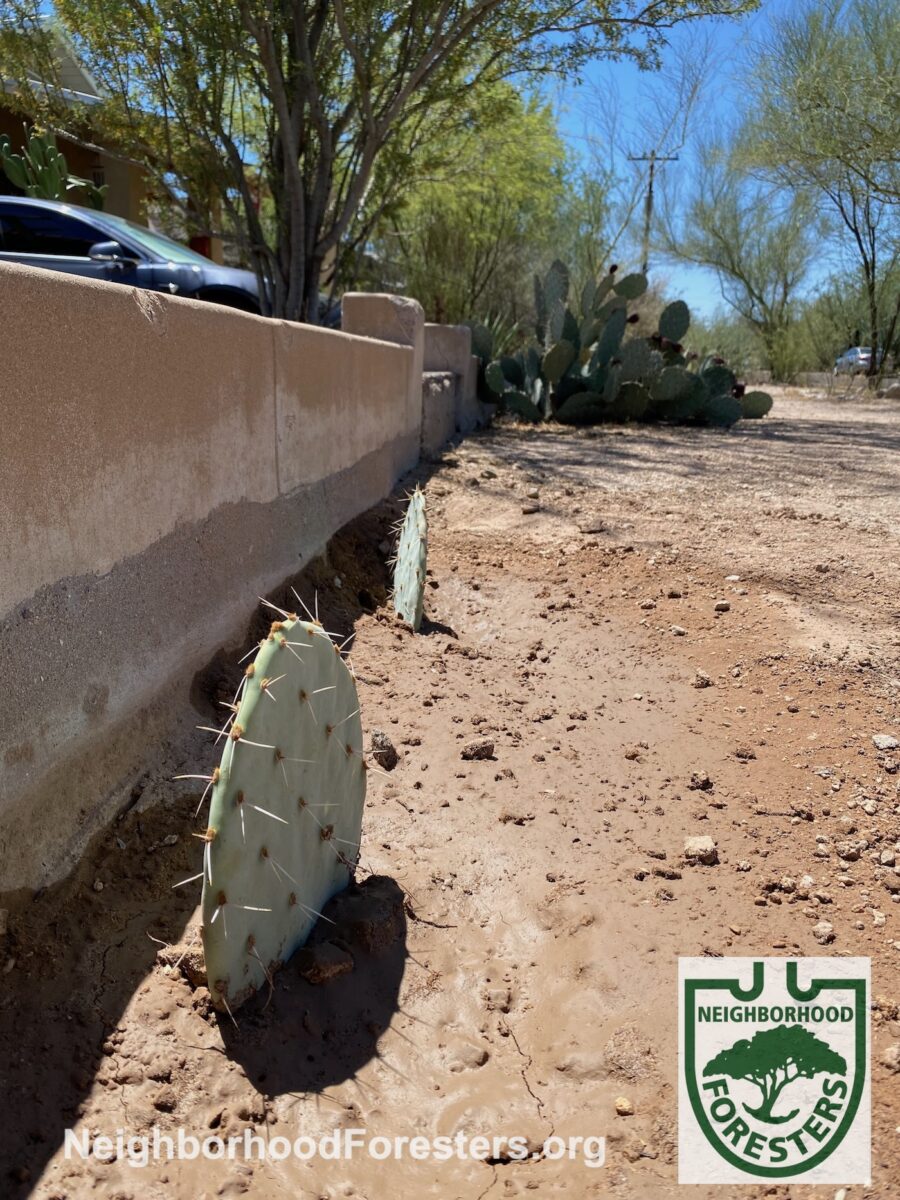
Photo: Brad Lancaster
Or plant in a pot to root before transplanting in ground later.
With pad in pot full of soil, turn the pot so the pad has the same orientation it did when on the mother plant. Then mark an “X” on the south-side of the pot (with white wax pencil), and make sure you keep the side of the pot with the “X” always facing south.

Photo: Brad Lancaster
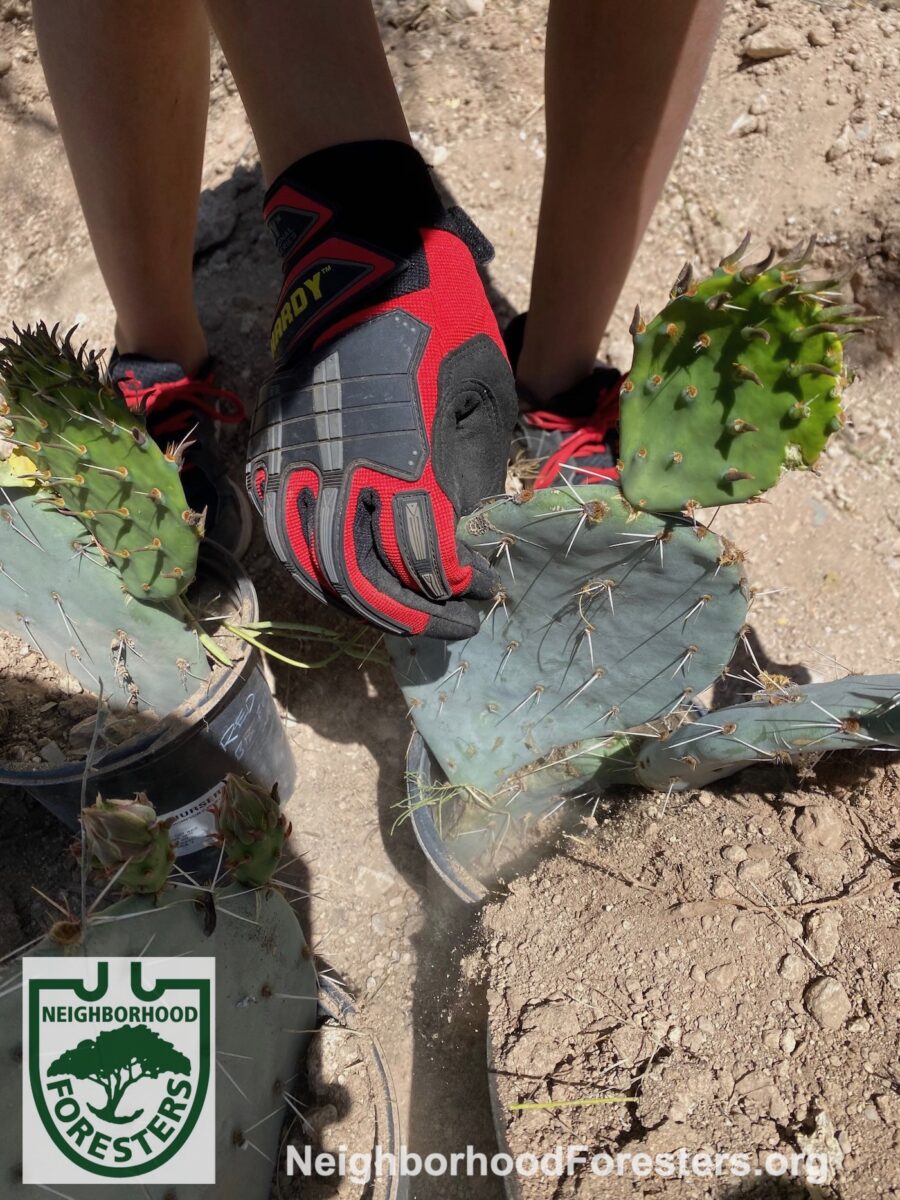
Photo: Brad Lancaster
Water once a week in the hot summer months to encourage quicker root growth. Pads in pots will do better if shaded from the west sun.
Then plant in the ground within a shallow (six-inch deep) water-harvesting basin, orienting the pad so when in the ground it maintains the same orientation it had on the mother plant (this will reduce the chance of the newly planted pad getting sunburned. If a side of the pad that had always faced shade, like north, were suddenly oriented to the full sun to south or west it will more likely sunburn).
Make sure you space your new planting far enough away from foot paths and such, so it won’t cause a future conflict. As the prickly pear tend to grow to 5 feet diameter, make sure your newly pad is at least 3 feet from anything you don’t want it to conflict with—this way you won’t need to prune the cactus in the future.
Or plant in a pot to root before transplanting in ground later.
With pad in pot full of soil, turn the pot so the pad has the same orientation it did when on the mother plant. Then mark an “X” on the south-side of the pot (with white wax pencil), and make sure you keep the side of the pot with the X always facing south.
Water once a week in the hot summer months to encourage quicker root growth. Pads in pots will do better if shaded from the west sun.
If the rains are good, the rootless cactus pad planted in the ground, should be established and able to thrive without supplemental irrigation after six months.
Transplanted rooted pads can establish even quicker.
Local plant nurseries that sell native prickly pear

And you can share info on how to plant, harvest, process, and enjoy the bounty.
Photo: Brad Lancaster
Urban forestry with prickly pear
Prickly pear is not mistaken for a weed, so it works great to plant it where poorly trained landscape maintenance crews mistakenly take out desired plants thinking they are “weeds”.
Prickly pear also works very well in hot, dry areas that will NOT get irrigation or stormwater running to them from adjoining areas.
It works well as a pioneer plant that begins the revegetation of an otherwise bare area.
It can also be planted to create a living barrier protecting more tender plants that might get trampled when young and small.
Staghorn cholla can be used in a similar way.

